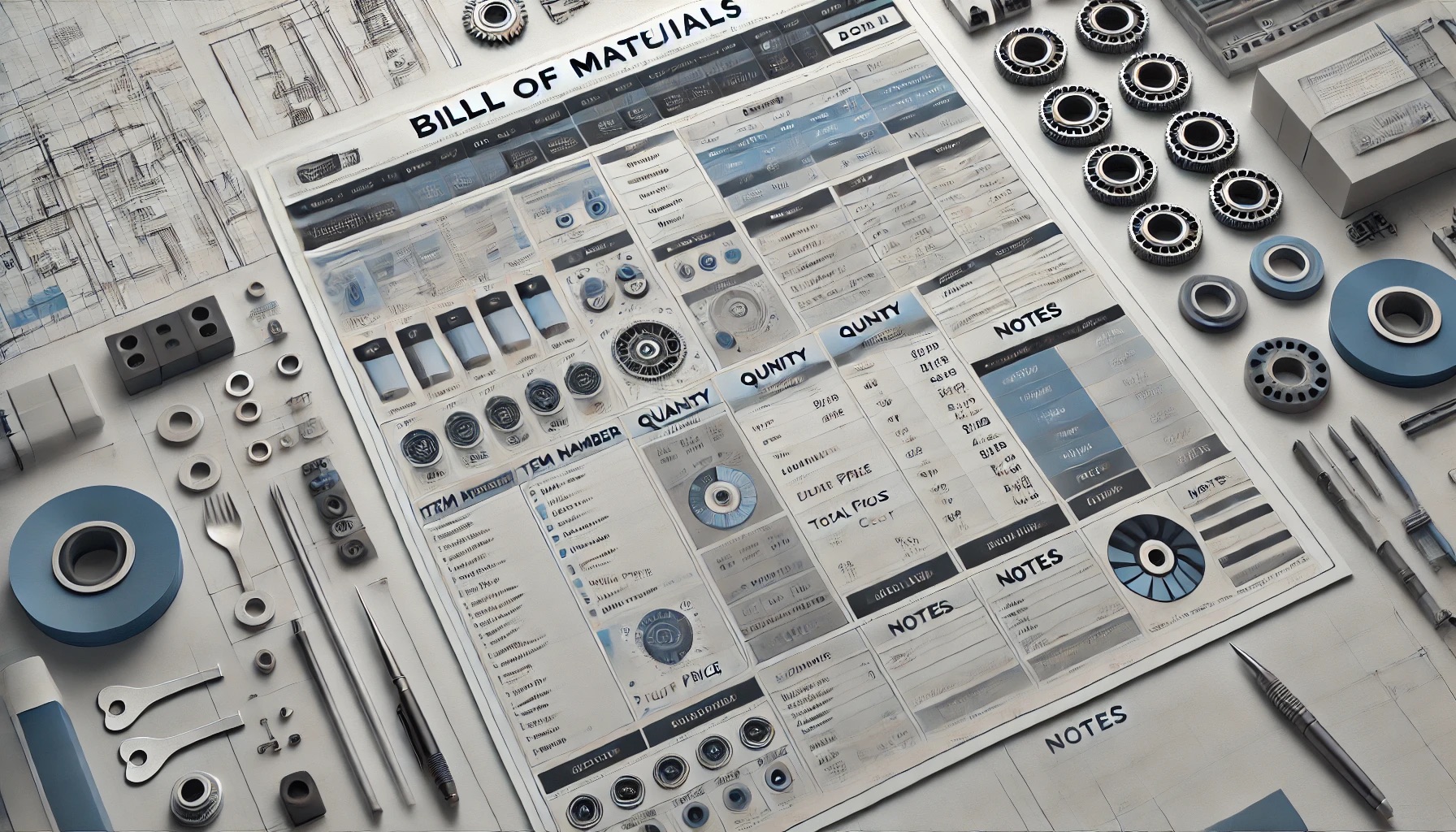A Bill of Materials (BOM) template is a vital tool for businesses aiming to manage resources effectively. From raw materials to external vendors, this document provides a clear breakdown of all the components required for production. By leveraging a BOM template, businesses can enhance their operational efficiency, streamline communication, and improve overall production planning.
In this article, we’ll explore the various types of BOM templates, their features, and how to create one that suits your business needs. By understanding the nuances of each type, you can design a BOM template that optimizes your production process and contributes to your company’s growth.

What Is a Bill of Materials?
A Bill of Materials is a comprehensive document that outlines the components, raw materials, and assemblies needed to manufacture a product. It serves as a reference tool for manufacturers, detailing every physical part required for production, supplier contact details, and the average cost per unit.
A well-structured BOM ensures that:
-
Production planning is efficient and standardized.
-
Inventory management is streamlined.
-
Communication across departments is clear and consistent.
Whether you’re managing a small enterprise or a large organization, a BOM is indispensable for maintaining a smooth production cycle and ensuring the delivery of high-quality products.
Why Is a Bill of Materials Template Important?
1. Enhances Supply Chain Management
A BOM template allows businesses to track suppliers, ensuring a steady flow of raw materials. It also identifies potential issues in the supply chain, minimizing disruptions.
2. Standardizes Communication
By centralizing information, BOM templates ensure that all stakeholders—from engineers to production teams—are aligned.
3. Facilitates Cost Management
BOM templates provide a detailed breakdown of costs, enabling businesses to monitor expenditures and maintain profitability.
4. Improves Production Planning
With a clear outline of required materials and processes, BOM templates help teams anticipate needs, manage inventory levels, and avoid delays.
Types of Bill of Materials Templates
Different businesses require different types of BOM templates, each designed to cater to specific needs. Below are the most commonly used types:
1. Modular BOM
This straightforward template lists all necessary components in a hierarchical order. It organizes parts and sub-assemblies based on priority, making it ideal for managing multiple products with shared components.
Best For: Small to medium-sized businesses with straightforward production processes.
2. Manufacturing BOM
Focusing on tangible components, this template details all physical parts required for product assembly. It often includes descriptions of how components connect, providing clarity for manufacturing teams.
Best For: Industries with complex manufacturing needs.
3. Engineering BOM
This template is developed in collaboration with product engineers and focuses on the design perspective. It includes detailed descriptions of components and processes, ensuring the product meets engineering specifications.
Best For: Technology and mechanical engineering companies.
4. Equipment BOM
Designed to track equipment rather than components, this template lists all machinery required for production. It’s especially useful for businesses renting equipment and helps in cost comparisons.
Best For: Companies relying heavily on machinery for production.
5. Configurable BOM
This template accommodates products with multiple configurations, such as different colors or materials. It organizes all possible combinations, making it indispensable for businesses offering customizable products.
Best For: Companies with diverse product variations.
How to Create a BOM Template
Follow these steps to create a comprehensive and effective BOM template:
1. Determine the Categories and Data to Include
Identify all essential details, such as:
-
Material descriptions.
-
Supplier contact information.
-
Average costs and quantities.
-
Assembly instructions.
2. Align Teams on Data Input
Ensure all teams understand their roles in contributing accurate information. Consistency in data entry prevents errors and enhances the utility of the BOM.
3. Assign Responsibility for Revisions
Designate a team member to oversee updates and revisions. This ensures the BOM remains accurate and reflects the current stage of production.
4. Start Listing Components
Include every necessary item, from raw materials to equipment, in a structured format. Add detailed descriptions to minimize ambiguity.
5. Implement Regular Reviews
Periodically review the BOM to account for changes in suppliers, costs, or production requirements.
Where to Create a Bill of Materials Template
Several tools can help you create a BOM template, but Microsoft Excel stands out as the best choice. Its robust features make it ideal for managing complex data and customizing templates.
Advantages of Microsoft Excel
-
User-friendly interface.
-
Wide range of formatting options.
-
Easy integration with other tools and software.
-
Industry-standard for data management.
If you don’t have Excel, you can purchase affordable licenses from trusted sources like RoyalCDKeys. This ensures access to all the tools you need for creating an effective BOM.
Free Bill of Materials Templates to Download
If you prefer not to start from scratch, here are some ready-to-use templates:
Template 1: Comprehensive BOM Template
-
Includes sections for materials, sub-assemblies, and costs.
-
Best For: Complex manufacturing projects.
Template 2: Blank BOM Spreadsheet
-
Fully customizable for any type of BOM.
-
Best For: General-purpose use.
Template 3: Simplified BOM Template
-
Focuses on basic material listings and costs.
-
Best For: Small businesses with simple production processes.
Conclusion on Bill of Materials Template
A well-designed BOM template is a powerful asset for any business. It simplifies production planning, enhances supply chain management, and ensures cost efficiency. By choosing the right type of BOM for your needs and keeping it updated, you can streamline your operations and achieve better outcomes.
Start creating your BOM template today using the insights and free templates provided. With tools like Microsoft Excel, you can easily customize and maintain a document that meets your business’s unique requirements.
Source: What Is a Bill of Materials Template and Its Types
Don’t forget to explore our previous post: Your Key to a Successful Product Launch: Go-To-Market Strategy